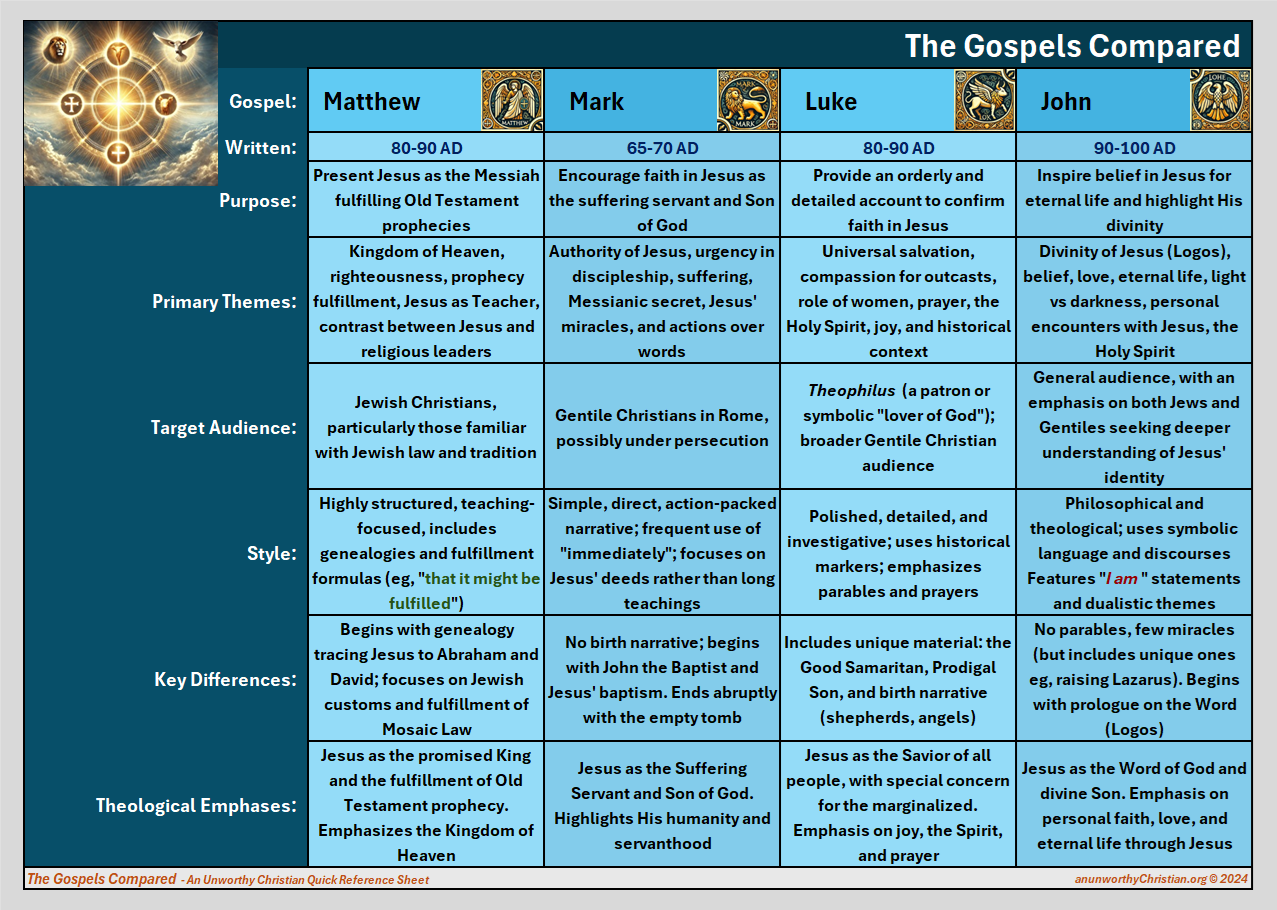
The Four Gospels
The four Gospels of the New Testament—Matthew, Mark, Luke, and John—offer distinct perspectives on the life, teachings, death, and resurrection of Jesus Christ. Each Gospel was written with specific purposes and audiences in mind, highlighting different themes to convey the significance of Jesus' ministry.
 Gospel of Matthew
Gospel of Matthew
Author and Date:
Traditionally attributed to Matthew, one of Jesus' twelve apostles and a former tax collector. Most scholars date this Gospel between 80-90 AD.
Purpose:
To demonstrate that Jesus is the long-awaited Messiah prophesied in the Hebrew Scriptures (Old Testament).
Primary Themes:
Fulfillment of Prophecy: Frequent quotations from the Old Testament showing Jesus as the fulfillment of messianic prophecies.
Kingdom of Heaven: Emphasis on the teachings about the kingdom and its ethical demands.
Righteousness: Calls for a higher righteousness exceeding that of the Pharisees.
Jesus as Teacher: Presents five major discourses, including the Sermon on the Mount.
Target Audience: Primarily Jewish Christians familiar with Jewish law and customs.
Distinctive Features:
Traces Jesus' genealogy to Abraham, highlighting His Jewish heritage.
Uses Jewish terminology and respects Jewish customs without explanation.
Emphasizes Jesus' role as the new Moses.
 Gospel of Mark
Gospel of Mark
Author and Date:
Attributed to John Mark, a companion of Peter and Paul. Likely the earliest Gospel, written around 65-70 AD.
Purpose:
To present Jesus as the suffering servant and Son of God, encouraging believers facing persecution.
Primary Themes:
Messianic Secret: Jesus often instructs others to keep His identity concealed.
Authority and Power: Highlights Jesus' miracles and authority over nature, demons, and illness.
Discipleship: Calls for self-denial and bearing one's cross.
Suffering and Sacrifice: Prepares readers for the reality of suffering in following Christ.
Target Audience: Gentile Christians in Rome, possibly undergoing persecution.
Distinctive Features:
Fast-paced narrative with the frequent use of "immediately."
Less emphasis on Jesus' teachings, more on His actions.
Provides interpretations of Jewish customs for Gentile readers.
 Gospel of Luke
Gospel of Luke
Author and Date:
Written by Luke, a physician and companion of Paul. Composed around 80-90 AD.
Purpose:
To provide an orderly account of events to assure readers of the truth they have been taught.
Primary Themes:
Universal Salvation: Jesus as the Savior for all people, Jews and Gentiles alike.
Compassion for the Marginalized: Focus on the poor, women, sinners, and Samaritans.
Prayer and the Holy Spirit: Emphasizes Jesus' prayer life and the role of the Spirit.
Joy and Praise: Frequent expressions of joy in response to God's redemptive work.
Target Audience: Addressed to Theophilus, likely a Gentile convert; broadly intended for Gentile Christians.
Distinctive Features:
Contains unique parables like the Good Samaritan and the Prodigal Son.
Provides detailed birth narratives of John the Baptist and Jesus.
Emphasizes historical context and sets events within world history.
 Gospel of John
Gospel of John
Author and Date: Traditionally attributed to John the Apostle, the "beloved disciple." Estimated to be written around 90-100 AD.
Purpose: To inspire belief in Jesus as the Christ, the Son of God, so that readers may have eternal life.
Primary Themes:
Divinity of Jesus: Strong emphasis on Jesus as the incarnate Word (Logos).
Light vs. Darkness: Symbolism highlighting spiritual truths.
Eternal Life: Focus on the promise of everlasting life through belief in Jesus.
Love and Unity: Calls for love among believers and unity with God.
Target Audience: A broad general audience, both Jews and Gentiles.
Distinctive Features:
Contains seven "I am" statements revealing Jesus' identity (e.g., "I am the bread of life").
Includes long discourses and dialogues, such as the conversation with Nicodemus.
Omits many events found in the Synoptic Gospels (Matthew, Mark, Luke) and introduces unique ones.
Major Similarities and Differences
Similarities:
Core Narrative: All Gospels cover key events like Jesus' baptism, miracles, teachings, crucifixion, and resurrection.
Purpose: Aim to convey the significance of Jesus' life and mission.
Message: Affirm Jesus as the Messiah and Son of God.
Differences:
Perspective and Style: Matthew presents a Jewish perspective; Mark is action-oriented; Luke offers a historical and compassionate view; John provides a theological and spiritual reflection.
Content: John differs significantly from the Synoptics, with unique miracles and discourses.
Audience: Each Gospel tailors its message to resonate with its intended audience, influencing its thematic emphasis.
Chronology: Differences in the order of events and the duration of Jesus' ministry.
The Gospel of John is notably different from the Synoptic Gospels—Matthew, Mark, and Luke—in both style and content. One of the key differences is the absence of traditional parables. Instead, John focuses on extended discourses, symbolic language, and profound theological themes. This has led many scholars to suggest that John was targeting a more mature Christian audience.
Absence of Parables in John
Teaching Style: While the Synoptic Gospels often portray Jesus teaching in parables to convey moral and spiritual lessons, John's Gospel lacks these parables. Instead, it contains lengthy dialogues and monologues where Jesus explains complex theological concepts.
Use of Symbolism: John employs symbolic "I am" statements (e.g., "I am the bread of life," "I am the true vine") to reveal Jesus' identity and mission. These require a deeper level of interpretation and understanding.
Target Audience
Established Believers: The content suggests that John's audience was already familiar with the basic tenets of Christianity. The Gospel aims to deepen their understanding and reinforce their faith.
Spiritual Maturity: The complex theological discussions about concepts like the Word becoming flesh (John 1:14), the relationship between the Father and the Son, and the role of the Holy Spirit imply an audience capable of engaging with advanced teachings.
Purpose of John's Gospel
Strengthening Faith: John explicitly states his purpose: "But these are written that you may believe that Jesus is the Messiah, the Son of God, and that by believing you may have life in his name" (John 20:31). This indicates a focus on cultivating a deeper belief rather than introducing basic teachings.
Addressing Challenges: The Gospel may have been written to address specific theological disputes or misunderstandings within the early Christian community, necessitating a more sophisticated approach.
Comparison with Synoptic Gospels
Parables as Teaching Tools: In the Synoptics, parables serve to teach moral lessons in a way that is accessible to a broad audience, including new converts and those unfamiliar with Christian teachings.
John's Advanced Themes: John's Gospel delves into advanced theological themes such as pre-existence, incarnation, and the nature of eternal life, which might be more relevant and comprehensible to mature believers.
Conclusion
The absence of parables in the Gospel of John, combined with its profound theological content, suggests that it was indeed aimed at readers who were more mature in their faith. The Gospel seeks to deepen their understanding of who Jesus is and what His teachings mean on a spiritual and existential level. While it remains accessible to all readers, its richness in symbolism and theology particularly resonates with those ready to engage with the complexities of Christian doctrine.
The below chart compares the four Gospels of the Bible. Click to view it full size.
